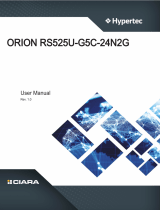
- 8 -
5-2-3 Intel(R) Ethernet Connection X722 .........................................................................63
5-2-4 Trusted Computing .................................................................................................67
5-2-5 Serial Port Console Redirection .............................................................................68
5-2-6 SIO Conguration ...................................................................................................72
5-2-7 PCI Subsystem Settings .........................................................................................75
5-2-8 Network Stack ........................................................................................................76
5-2-9 CSM Conguration .................................................................................................77
5-2-10 Post Report Conguration ......................................................................................79
5-2-11 NVMe Conguration ...............................................................................................80
5-2-12 USB Conguration ..................................................................................................81
5-2-13 Chipset Conguration .............................................................................................82
5-3 Chipset Setup Menu ....................................................................................... 83
5-3-1 Processor Conguration .........................................................................................84
5-3-2 Common RefCode Conguration ...........................................................................88
5-3-3 UPI Conguration ...................................................................................................89
5-3-4 Memory Conguration ............................................................................................91
5-3-5 IIO Conguration ....................................................................................................95
5-3-6 Advanced Power Management Conguration ........................................................98
5-3-7 PCH Conguration ...............................................................................................105
5-3-8 Miscellaneous Conguration ................................................................................110
5-3-9 Server ME Conguration ...................................................................................... 111
5-3-10 Runtime Error Logging .........................................................................................112
5-4 Server Management Menu ........................................................................... 116
5-4-1 System Event Log ................................................................................................118
5-4-2 View FRU Information ..........................................................................................119
5-4-3 BMC Network Conguration .................................................................................120
5-4-4 IPv6 BMC Network Conguration .........................................................................121
5-5 Security Menu .............................................................................................. 122
5-5-1 Secure Boot .........................................................................................................123
5-6 Boot Menu .................................................................................................... 126
5-6-1 UEFI NETWORK Drive BBS Priorities ................................................................128
5-6-2 UEFI Application Boot Priorities ................................................................. 129
5-7 Save & Exit Menu ......................................................................................... 130
5-8 BIOS POST Codes ...................................................................................... 132
5-8-1 AMI Standard - PEI ...............................................................................................132
5-8-2 AMI Standard - DXE .............................................................................................132
5-8-3 AMI Standard - ERROR .......................................................................................134
5-8-4 Intel UPI POST Codes ..........................................................................................135
5-8-5 Intel UPI Error Codes ...........................................................................................135
5-8-6 Intel MRC POST Codes .......................................................................................136
5-8-7 Intel MRC Error Codes .........................................................................................136




















